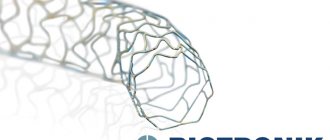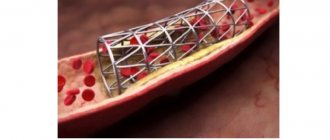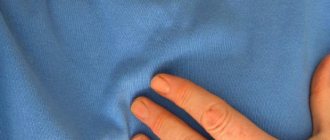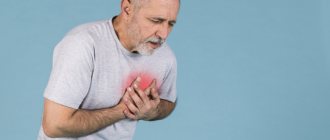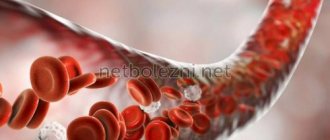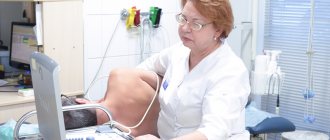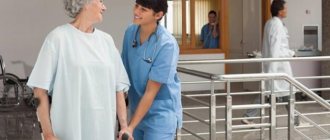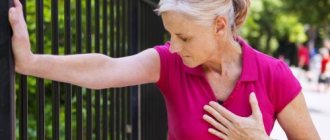Heart disease is always associated with a threat to the patient’s life; special techniques are being developed for their treatment and complete rehabilitation. Each patient needs an individual approach; specific methods can be adjusted taking into account objective changes in the condition. During a myocardial infarction, the heart muscle dies completely or partially due to insufficient blood supply; in most cases, coronary atherosclerosis leads to such consequences.
Stationary stage
At this stage, it is not so much the physical recovery of the patient that is important, but the moral one. He must believe that not everything is lost, that a healthy lifestyle can be completely restored, that the disease has receded for a long time and there is no need to be afraid of relapses. But the desired result can be achieved only under one condition - the patient himself will make every effort and unconditionally follow all medical recommendations.
During the stationary stage of physical rehabilitation, the sick person must fully take care of himself and take walks of two to three kilometers. In addition, exercise therapy efforts should ensure:
- localization and elimination of complications that arise after prolonged bed rest. Consequences of outpatient treatment may include intestinal disturbances (atony), thromboembolism, and congestive pneumonia. Restoring movement makes it possible to restart the vital functions of the body;
- the maximum possible restoration of the performance of the cardiovascular system at the initial stage, training of peripheral circulation. In this case, the load on the heart is selected as sparingly as possible, the patient is constantly monitored;
- orthostatic stability, restoration of simple motor functions.
As soon as the patient is convinced of the progress of the results of the fight against the disease, he will have positive emotions and confidence in his future. Normalization of mental state also plays a very important role in the process of returning to a normal lifestyle.
Condition assessment
After carrying out exercises and various activities, a number of parameters are assessed:
| Index | Change |
| General state | Moderate fatigue Severe fatigue that does not go away for a long time |
| Angina pain | No Moderate, goes away on its own Severe, require medicinal correction |
| HELL | The increase for the upper one is no more than 40 mm Hg. Art., lower - no more than 12 Or a decrease in indicators of no more than 10 units |
| Heart rate | Increase by no more than 20 per minute or decrease by 10 units maximum |
| Breathing problems | An increase of no more than 6 per minute is acceptable. |
| Changes on the cardiogram | Signs of impaired blood flow (decreased ST segment) Violation of the rhythm of contractions Blockade of impulse conduction |
Is it possible to return to normal life after a heart attack?
The duration and quality of rehabilitation depends on the influence of many factors, primarily the severity of the heart attack.
Concomitant pathologies and complications, age and occupation, etc. play a role. During rehabilitation (and not only) a diet should be followed, the risks of stressful situations should be minimized, a healthy lifestyle should be maintained, preventative medications and medical supervision should be performed. The list and nature of measures is selected for each patient and should be applied in combination.
Stages of rehabilitation1
All stages are carried out under the supervision of specialists, starting from the resuscitation team in the intensive care unit (ICU) and ending with a cardiologist in the clinic.
Stage 1.
Inpatient – begins from the moment of admission to the hospital (cardiac intensive care unit, ICU, cardiology department). Main activities: diagnosis, treatment after restoration of patency of the coronary vessels, assessment of the prognosis and risk of complications of MI.
Stage 2.
Inpatient rehabilitation – takes up the entire acute period of MI (up to 28 days) after the patient is transferred to a specialized rehabilitation or heart attack department, and then to a cardiological sanatorium. This is where more intense physical activity becomes possible.
Stage 3.
Outpatient – carried out in a clinic and at home under the supervision of a cardiologist and a physical therapist. The prevention of recurrent heart attack, coronary heart disease, and treatment of atherosclerosis comes to the fore. Dispensary observation continues for a year or longer.
The division into stages is determined, among other things, by the periods of the disease:
- The most acute period is up to 6 hours,
- Acute MI – up to 7 days after the attack,
- Scarring stage – up to 28 days,
- The stage of a formed scar is from 29 days after the attack.
Rehabilitation covers all aspects of the patient’s health: physical, psychological, social. It includes drug and non-drug treatment methods, such as physiotherapy, lifestyle and diet adjustments, gradual return to physical activity and psychological support.
The effectiveness of rehabilitation affects the survival of patients after MI and quality of life.
Physical activity
After illness, physical activity should increase gradually; forcing events often causes very serious complications. After several days after the acute period, the patient can slowly (on his own or with the help of others) get out of bed, holding the supports with his hands. The first steps can be taken only after transfer to a regular ward. You can only walk on a flat surface and avoid shortness of breath or feelings of fatigue. The duration and distance of walking increases gradually.
In a hospital, a doctor must supervise exercise therapy classes. The same exercises can be performed at home after leaving the hospital. In this case, you should constantly remember to monitor the condition. One of the important indicators of a successful rehabilitation course is pulse and blood pressure. After normal physical exercise, the frequency of contraction of the heart muscle should not exceed 100–120 beats per minute.
Heart attack and stenting
A heart attack is a condition of the human body in which tissue necrosis occurs, which occurs when the supply of blood to parts of the body is disrupted. This pathology can affect not only the heart muscle, but also other organs. It is believed that myocardial infarction is the most dangerous manifestation of the disease.
There are 2 types of heart attack:
- Large-focal . Serious pathology that may result in complete disability;
- Finely focal . A milder disease, after which the functionality of the body can be fully restored.
Important
! If you suspect this pathology, you should immediately consult a doctor in order to receive timely medical or surgical treatment, ensure peace, and increase the chances of a full recovery.
A little more than a century ago, doctors widely recommended abandoning physical activity during rehabilitation after stenting of cardiac vessels.
Patients were prescribed bed rest for two months without the ability to move even around the apartment. However, at the moment the situation has changed dramatically.
Studies have shown that earlier restoration of physical activity promotes a speedy recovery and also reduces the risk of another heart attack.
An inactive lifestyle is an unusual state for human nature. Lack of physical activity leads to serious health problems. And refusal of exercise therapy at the stage of rehabilitation after bypass surgery can cause the formation of blood clots in the arteries, leading to the development of pneumonia and other complications.
People who have had a heart attack often lose their zest for life, become depressed and refuse rehabilitation. A set of physical exercises helps to successfully combat a depressed mood by improving blood circulation and restoring heart function. Small changes and a gradual increase in load give the patient hope for a speedy recovery.
When continuing treatment at home, rehabilitation after hospital plays a huge role. When carrying out this procedure, the patient must adhere to certain rules:
- Change your diet and diet;
- Review your general lifestyle;
- Stop drinking alcohol and quit smoking;
- Constantly resort to therapeutic exercises, which will reduce the likelihood of a recurrence of the attack.
Physiotherapeutic procedures
They are considered an important addition to physical rehabilitation methods and significantly speed up the process of restoring important vital signs. Most often it is recommended to do self-massage and breathing exercises. If the course of rehabilitation is favorable, gradual exercise with measured loads and time is allowed. These types include ordinary walking over longer distances, race walking, swimming, and cycling.
Nutrition
Depending on the period of illness, three different diets are recommended.
- The first week after an acute attack. When preparing food, salt is completely excluded; you can only steam or boil it; you are prohibited from eating fried foods. To facilitate the work of the intestines, food is pureed, the number of meals is increased to seven times a day, and the size of portions is reduced. You are allowed to drink up to 800 ml of liquid.
- Second and third week. Still, salt is not used and fried foods are prohibited. There is no need to wipe, just finely chop. The number of receptions is reduced to 5, and the size of portions increases slightly. The amount of liquid you drink increases to a liter.
- Fourth week (period of myocardial scarring). When cooking, salt is not used; dishes are steamed or boiled. The number of meals is reduced to four, and the portions increase. It is allowed to take large pieces of food, the volume of liquid drunk increases to 1.1 liters. If the doctor considers it possible, then a little (up to 4 g) table salt is allowed.
Relapse Prevention
The work of the heart muscle depends on the psycho-emotional state and physical activity. Both factors can have both positive and negative effects on the patient's condition. Some suspicious patients think that the appearance of any pain in the heart area indicates an imminent return of the disease, causing them confusion, fear of death and anxiety.
Panic can last for several months from the moment the first pain appears, but over time everything is forgotten and returns to its usual routine. To eliminate fear, it is recommended to contact your doctor or psychologist; it is strictly forbidden to overload the nervous system for a long time. The patient must learn to independently manage emotions correctly and prevent stressful situations from arising. Depending on individual characteristics, the total duration of rehabilitation can reach three months or more.
After a myocardial infarction, the patient is prohibited from drinking all alcoholic beverages without exception, and he is not allowed to smoke. Refusal prevents the recurrence of cardiac pathology, and failure to follow a healthy lifestyle significantly increases the risks to life.
Treatment of obesity is one of the mandatory conditions for rehabilitation after a heart attack.
The benefits and goals of exercise therapy after a heart attack
The term exercise therapy (therapeutic physical education) refers to the regular implementation of rehabilitation programs. They include exercises with subsequent complication. Physical education is used as an auxiliary therapy in eliminating the consequences of myocardial infarction and preventing complications after pathology.
A well-designed set of exercises after a heart attack and stenting will help solve a number of problems. The goals of physical education are to prevent the development of diseases:
- heart and respiratory failure;
- thrombosis;
- arrhythmias;
- intestinal atony;
- narrowing of the lumen of arteries and veins;
- spasm of blood vessels;
- metabolic disorders;
- poor blood supply to the heart muscle and other organs;
- pathological reaction of the adrenal glands to hormonal drugs.
During productive exercise therapy, myocardial microcirculation and peripheral blood supply to the extremities are restored.
The main goal of conducting physical exercises for patients in the cardiology department is to prevent recurrent myocardial infarction and other pathologies of the cardiovascular system. Physical education helps not only to lose excess weight, strengthen the nervous system and psyche, but also to almost completely restore a person.
The patient, following the instructions of the cardiologist and rehabilitation specialist, quickly returns to the usual rhythm of life, the ability to self-care and professional stress.
Rehabilitation after coronary stenting
The use of coronary stenting during the treatment of heart diseases began to be used relatively recently. The problematic area of the artery is expanded using a wire frame (stent), which expands the vessel to physiological sizes.
During the operation, the chest is not opened, which greatly facilitates the patient’s rehabilitation process and reduces the total time spent in a medical facility.
Non-drug methods of prevention
After myocardial infarction, atherosclerosis, which most often causes vascular accidents, continues to develop. To prevent its progression and recurrent MI, it is necessary to minimize the effect of risk factors. For this purpose, non-drug and drug methods of secondary prevention of coronary heart disease (CHD) are used.
Non-drug methods, in addition to physical rehabilitation, include lifestyle correction. This concept includes:
- Complete cessation of smoking
, both active and passive. It has been proven that nicotine and other chemical compounds damage the inner lining of blood vessels (endothelium) and contribute to an increase in the level of “bad” cholesterol, that is, low-density lipoproteins. In addition, smoking leads to vasospasm and an increase in blood pressure, which can provoke new attacks of coronary artery disease. Research data has shown that quitting smoking reduces the risk of death by 36%! - Avoid or minimize alcohol consumption .
The heart primarily suffers from alcoholic drinks: tachycardia, arrhythmia appear, blood pressure increases, the toxic effect of ethanol can lead to another heart attack or sudden death. The permissible dose is 30 g per day for men and no more than 20 g for women. - Weight control and healthy eating.
It is necessary to balance the diet so as to maintain normal body weight and metabolism. Basic principles: reducing animal fats, replacing them with plant foods that do not contain cholesterol. Preference should be given to vegetables, fruits, nuts, lean meats and sea fish, and whole grain cereals. Smoked, canned, fried and salted foods are excluded. It is convenient to control your weight using your body mass index (the result of dividing your weight in kg and height in meters squared). It should be within 25-27 kg/m. In addition, the waist circumference is assessed: for men this figure should not exceed 94 cm, for women – 80 cm.
Ways and methods of rehabilitation
After surgery, you can use the same rehabilitation techniques as for other methods of treating coronary artery disease.
Physiotherapy
Physical education comes first. But the load and types of exercises are adjusted depending on the course of the disease and the speed of recovery of the body. Due to the fact that damage to the heart muscle has not reached irreversible effects, therapeutic exercises can be performed with increased loads.
Most patients are recommended to engage in a health path - strictly dosed in terms of inclination, distance and time, walking in the fresh air along specially selected routes.
In gyms you can exercise on so-called cardio equipment - bicycles and treadmills. The intensity, duration and tempo are selected individually, the loads increase gradually. The patient is obliged to monitor his well-being, before starting classes and immediately after their completion, check his pulse and blood pressure.
Physical activity plays a complex positive role, it trains muscles, improves emotional state and helps to reduce excess weight. In addition, the blood supply and performance of all the patient’s organs are normalized. There are no special sets of exercises, but everyone is recommended to adhere to several general rules.
- Do exercises daily. To do this, it is not necessary to visit gyms; it is enough to do gymnastics at home, jogging or walking in the fresh air.
- Do not force the intensity of the loads. A set of exercises should not make you feel very tired.
- You should exercise not only during rehabilitation, but also after it.
If discomfort occurs or blood pressure rises excessively, then you need to reduce the duration and intensity of exercise.
Psychological rehabilitation
A very important link in the complex of prescribed measures. Constant fear of recurrence of the disease can cause a persistent state of stress. And this has an extremely negative impact on the functioning of the cardiovascular system, increasing risk factors for coronary artery disease, heart attacks and strokes. A professional specialist will help you cope with unreasonable worries and teach you how to manage your emotions. Another important point is that loved ones and relatives should treat the patient with understanding and attention and minimize the number of stressful situations caused by family circumstances.
Diet
Proper nutrition should simultaneously perform several tasks: help stabilize weight within optimal parameters, ensure the body is fully nourished, and prevent an increase in cholesterol levels in the blood. In this case, special attention should be paid to reducing the amount of products that cause a narrowing of the lumen of blood vessels.
Traditionally, foods that cause increased cholesterol formation are excluded; you should not abuse strong coffee and tea.
It is necessary to increase the consumption of vegetables and fruits in any form, make meals smaller.
Sanatorium-resort rehabilitation
A very effective method, the patient is under constant medical supervision. It is possible to accurately adjust the exercises and prescribe, if problems are detected, special supportive drug treatment. Some patients are recommended to take medications to prevent blood clots.
For the walls of blood vessels, the stent is a foreign body, the body tries to block it. Clots form in the blood, which can stick to the stent and break off over time under the influence of increased physical activity or stressful situations. The period of continuous use of medications can be up to a year. Changes in postoperative support methods are made only on the basis of clinical and laboratory test data. Read about watery acne on our website.
A set of exercises after a heart attack
The exercise therapy complex after myocardial infarction or measures taken to eliminate and prevent it is divided into 7-8 stages, the first 4 are carried out in the hospital. The simplest exercises are included, which must be performed in strict sequence. Their complexity increases with each stage.
Stage 1
Physical education begins 2-3 days after a diagnosed myocardial infarction. The duration of the lesson does not exceed 10 minutes per day. Most of the exercise therapy takes place on the patient's bed, he performs it lying down. The doctor helps the patient perform fairly simple exercises:
- bend your fingers and toes;
- rotational movements of the hands and feet;
- relaxation and tension of muscles in parts of the body alternately;
- sitting up in bed with the support of medical staff and medical devices.
Breathing exercises are also important: the patient inhales and exhales slowly, and does not hold his breath for long.
After each exercise, the sick person should rest. The rest time is approximately the same as that used to perform the action. Each exercise is performed slowly.
After physical education, the patient’s condition is diagnosed. The following indications are considered satisfactory:
- heart rate increases by 20 positions or decreases by 10;
- breathing rate is 10 cycles higher;
- increase in pressure up to 30 mm Hg.
If the criteria differ, exercise therapy is stopped and postponed for several days.
If the patient responds well to physical exercise, the actions become more complicated:
- alternately bend the fingers;
- rotate with hand, elbow;
- bend your arms at the elbows, bend your legs at the knees;
- rotate their head, tilt it.
After 3-4 days of positive dynamics, they move on to the second, more complex stage of restorative physical education.
Stage 2
The second stage of exercise therapy includes the previous exercises, but they are done more often, for example 3 times a day. Then, after 2-3 days, the following is added to the previous actions:
- large amplitude of rotation in the elbow, shoulder, knee and hip joints;
- sitting up on the bed independently (using special devices);
- sitting on the edge of the bed, legs down.
From the previous position, the person tries to rest his feet on the floor and then stand up. After a few days he can walk 2-3 steps next to the bed. The patient is allowed to sit at the table when eating.
The charging time is already 15-20 minutes.
Stage 3
If the patient’s blood pressure does not increase during exercise, dizziness, heart pain and other negative conditions are not observed, he is transferred to the third stage of physical therapy.
A person, accompanied by a medical worker and using a walker, walks through the ward to the toilet and goes out into the manipulation room. Steps should be slow; if the patient is tired, he should be allowed to rest on a chair or standing. Next, you can try going down or up the stairs one flight. Experts recommend drawing up a general route for a sick person of 200 m per day.
A set of exercises is carried out sitting or standing:
- rotations, head tilts;
- muscle tension in each individual body segment;
- rotation of arms, legs;
- lifting arms and legs.
If the results are good, the patient is allowed to twist and bend the body. Perform the exercises in the morning and evening, the duration of the session is no more than 20-25 minutes.
4th stage
The fourth stage of exercise therapy includes more complex exercises. The patients have practically recovered and are ready for an independent lifestyle. The ;-th stage is prescribed approximately 25-30 days after myocardial infarction. Classes are held in specialized halls or outdoors:
- turns and tilts the body;
- stepping on a step (step platform);
- circular movements in the limbs;
- swing your arms and legs;
- raising alternately arms and legs;
- walking on toes and heels;
- rotational movements of the waist, hips;
- walking with high knees.
Patients are allowed to walk with the support of medical staff or relatives. The steps should be slow, the distance should be up to 500 m. Then the distance traveled should be increased to 1 km. But you can’t overexert yourself; rest is required.
After completing the fourth stage, those who have suffered a myocardial infarction or stenting are sent to sanatorium-resort treatment. There they continue exercise therapy with a higher load. Usually a warm-up is expected, and then a light jog, squats, and mini-games with the ball.
